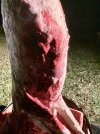There have been a couple of mentions of heavy bullets, but no discussion of sectional density. I believe that a high sectional density makes up for a lot of potential bullet weaknesses. I got a real education in this with muzzleloaders shooting .45 caliber pure lead bullets. To get a sectional density close to .280 (which is where I want to be for elk) takes a 405 gr. bullet. Most muzzleloader bullets are 250 to 300 gr. A 400 gr. pure lead bullet on the point of the shoulder, cracked the ball joint, and split in two. The cow ran 75 yards. Luckly for me, half went into the lungs and the other half into the neck. Once I started using a heavy jacketed .45-70 bullets, elk started dropping in their tracks.
I believe it takes a special bullet to perform well at over 3000 ft./sec. impact velocity. Most bullets are not designed to handle that. I just ordered some Eld-M and Eld-X bullets on the theory that the X would work on the closer shots and the M would be better for long range. My experience is that you have time on the long shots, so switching bullets isn't a big deal. For years I've used the 7mm 168 Bergers at 2850 on everything from javelina to elk. No issues, but their price has gone up with their popularity.
I started using Barnes bullets back in the '90's because my butcher put recovered bullets in a pan on the counter. All of the Barnes bullets looked just like the advertisements. I killed 4 aoudad with 120 gr. TTSX at 2400 frps from a 7-30 Waters.
The bottom line is you have to select the right bullet for the velocity. For javelina from a 10" Contender pistol in 7mm TCU, a regular bullet wouldn't expand. A varmit bullet does.



